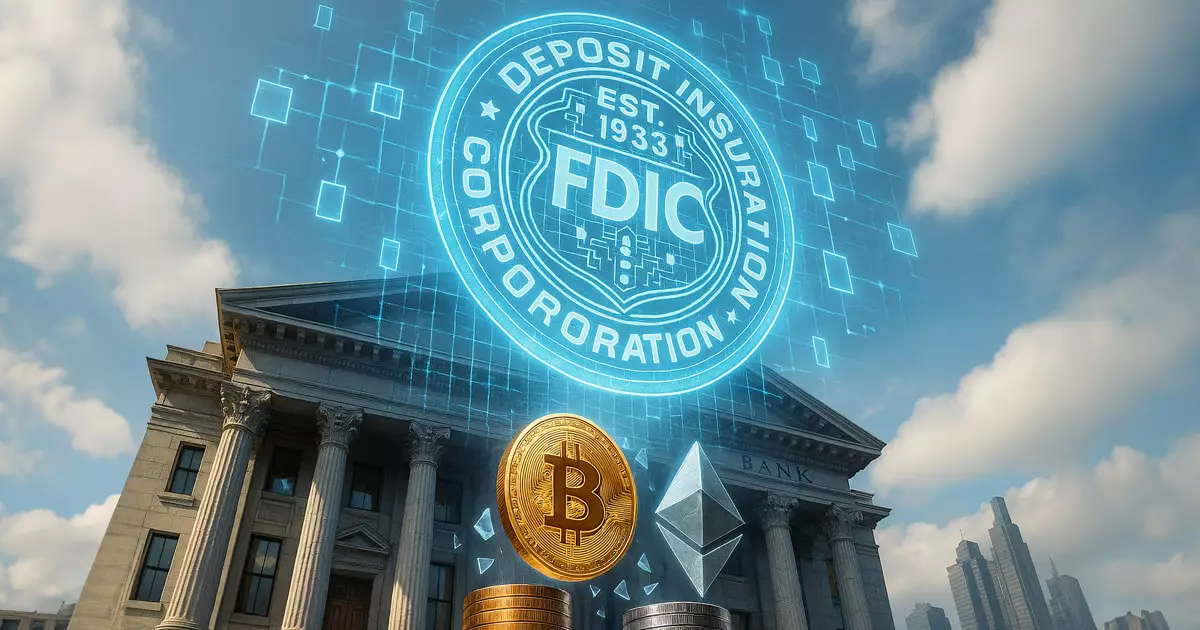In a remarkable pivot, the Federal Deposit Insurance Corporation (FDIC) is now crafting a more open and clear framework for U.S. banks to engage with cryptocurrency. Gone are the days when a blanket prohibition dominated the discourse surrounding public blockchains. At the recent American Bankers Association Washington Summit, FDIC Acting Chairman Travis Hill articulated a vision that not only acknowledges the importance of blockchain technology but embraces its potential benefits provided there are suitable controls in place. This newfound openness feels like a breath of fresh air in an otherwise stagnant regulatory landscape that has historically stymied financial innovation.
What’s commendable is that Hill’s acknowledgment of the U.S. being behind other jurisdictions is a refreshing dose of reality. While countries abroad have seen banks utilizing public blockchains, America’s conservative posture toward such technological advancements has limited its growth. Hill’s speech signals that the FDIC is finally ready to align with modern financial ecosystems, albeit with caution—a stark contrast to their former rigidity.
The Need for Guardrails: A Balancing Act
However, this openness doesn’t equate to an unfettered free-for-all. Hill emphasized the necessity for “appropriate guardrails.” This duality between innovation and prudence is critical. Allowing banks to engage with public blockchains while simultaneously enforcing rigorous risk management protocols can set a precedent for how other financial agencies can approach burgeoning technologies. The FDIC’s commitment to evaluating interagency guidance is vital—it illustrates a willingness to refine the existing framework as the industry evolves.
Moreover, the discourse surrounding the blurred lines between open and permissioned blockchain environments can hardly be overlooked. This complexity adds layers to the regulatory debate, leading to questions about how blockchain efficacy can coexist with traditional banking practices. It invites an array of regulatory questions that require nuanced understanding and clarity.
Setting Standards for Digital Assets
A significant portion of Hill’s address revolved around the evolving landscape of digital assets, including emerging discussions surrounding stablecoins. The FDIC’s interest in pass-through deposit insurance and enhanced eligibility guidelines for stablecoin reserves showcases a determination to foster an environment where digital innovations coexist safely alongside conventional banking practices. Hill’s remarks reveal an urgent need to clarify liquidity risk management, safeguards against illicit finance, and cybersecurity standards—points that are essential as the lines between traditional finance and cryptocurrency blur.
The push for a consistent regulatory framework cannot be overstated. If the FDIC can establish a clear supervisory perspective for responsible blockchain engagement, it could serve as a roadmap for how various financial institutions interact with novel technologies in a risk-averse yet progressive manner. Moreover, positioning regulatory standards is crucial in fostering investor confidence—a fundamental element often underestimated in the speed of digital asset innovations.
Challenging Traditional Notions of Deposits
In a thought-provoking assertion, Hill stated, “deposits are deposits,” emphasizing that the underlying technology doesn’t change their nature. Yet, this raises significant questions regarding potential risks during crisis situations, especially concerning counterparty capability to withdraw funds post-bank failures. What happens when smart contracts complicate manual interventions during a bank resolution? Such considerations warrant discussion and diligent planning.
The move to merge traditional protections with blockchain programmability is indicative of a necessity for modern financial regulations to adapt rather than resist change. Nevertheless, the risks associated with liquidity management in a gut-wrenching crisis remain daunting—even for the most forward-thinking institutions. It’s a balancing act that demands not only sharp foresight but also comprehensive technological solutions.
A Vision for the Future: Cooperative Regulation and Technological Alignment
The FDIC’s revised guidance embodies a monumental shift in the lighting of the path forward for crypto integration into the American banking system. We see a palpable commitment to exploration rather than exclusion, which is vital in today’s rapidly evolving economic landscape. As stakeholders grapple with new methods of transaction, the call for careful supervision evolves into an urgent necessity. There is an implicit invitation extended to innovative thinkers and regulators alike to work collaboratively through the minefield of digital evolution, eliminating fears that have been historically associated with cryptocurrencies and establishing a thriving ecosystem for all.
Hill’s observations suggest that even as the FDIC embraces go-forward strategies, they are keenly aware of the inherent risks in a world governed by complex digital frameworks. Engaging with the nuanced distinctions between blockchain capabilities and established banking protocols will be critical. And while pushing forward, the FDIC articulates a vision that is clear: the road to banking modernization is achievable, but only underpinned by careful, adaptive governance.


Leave a Reply